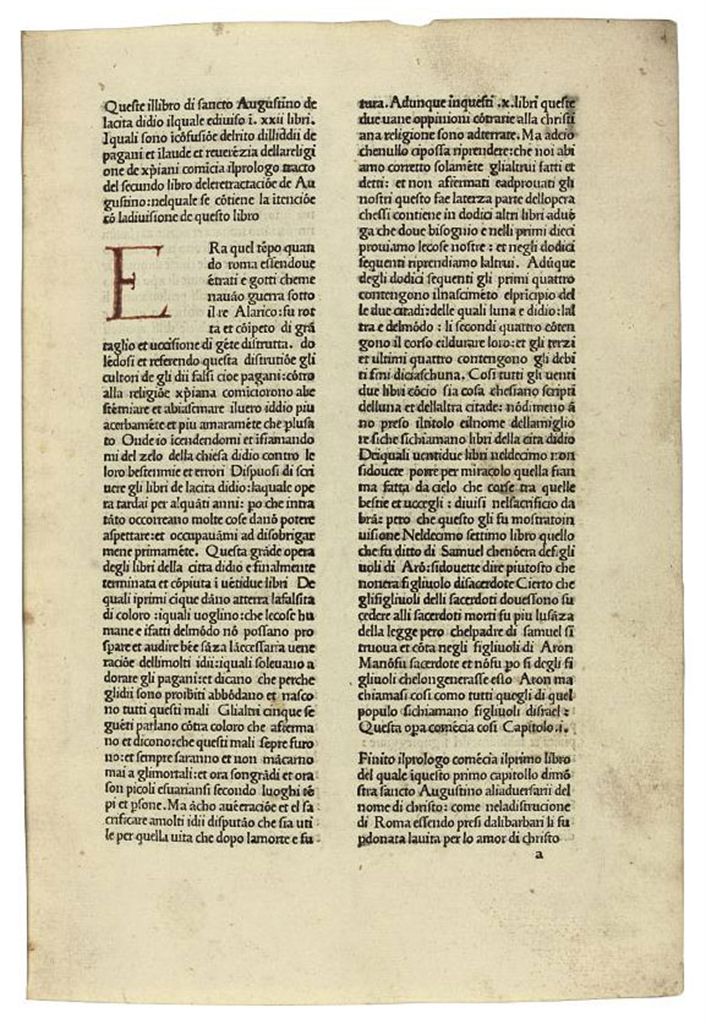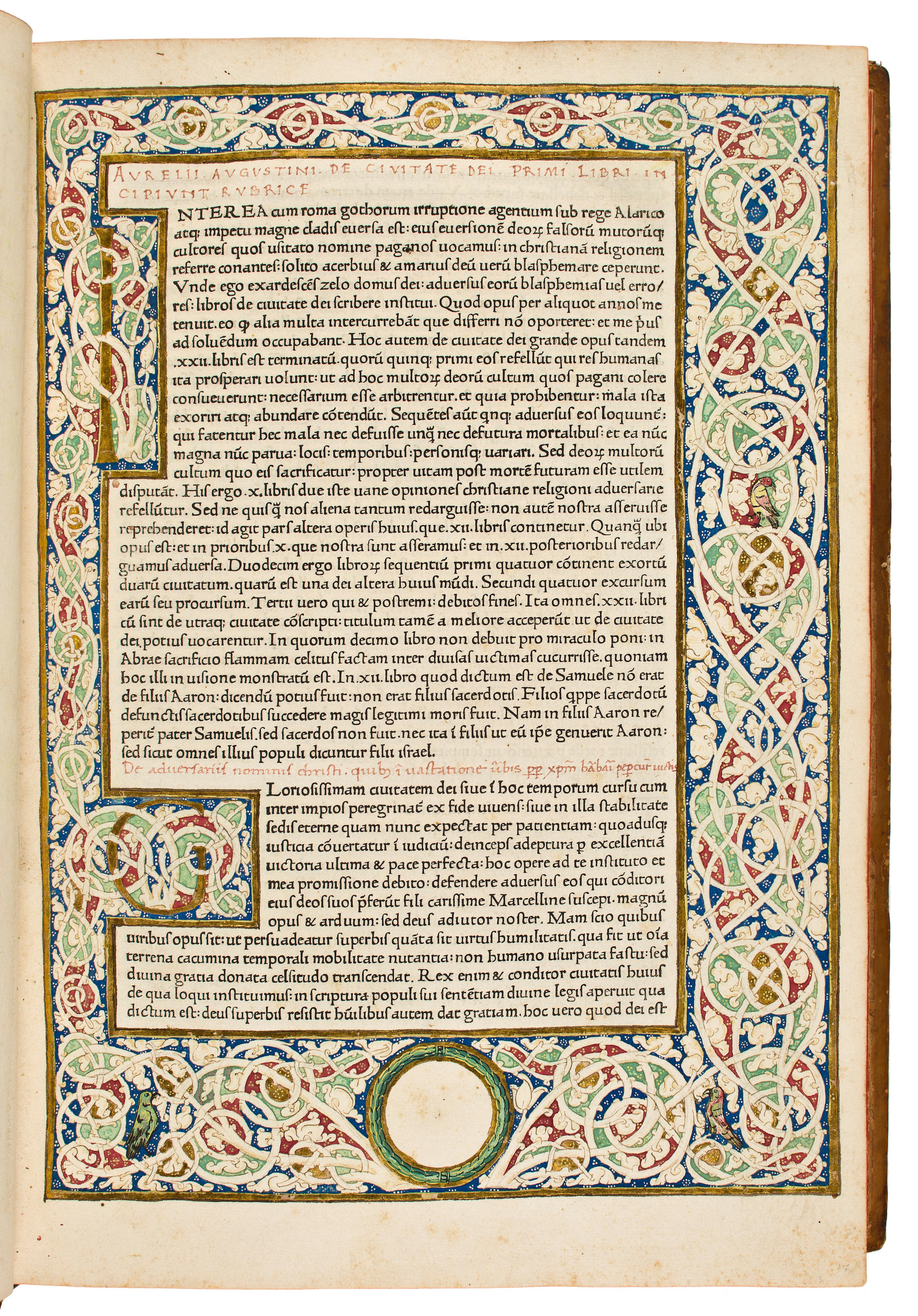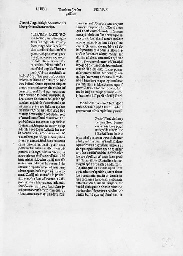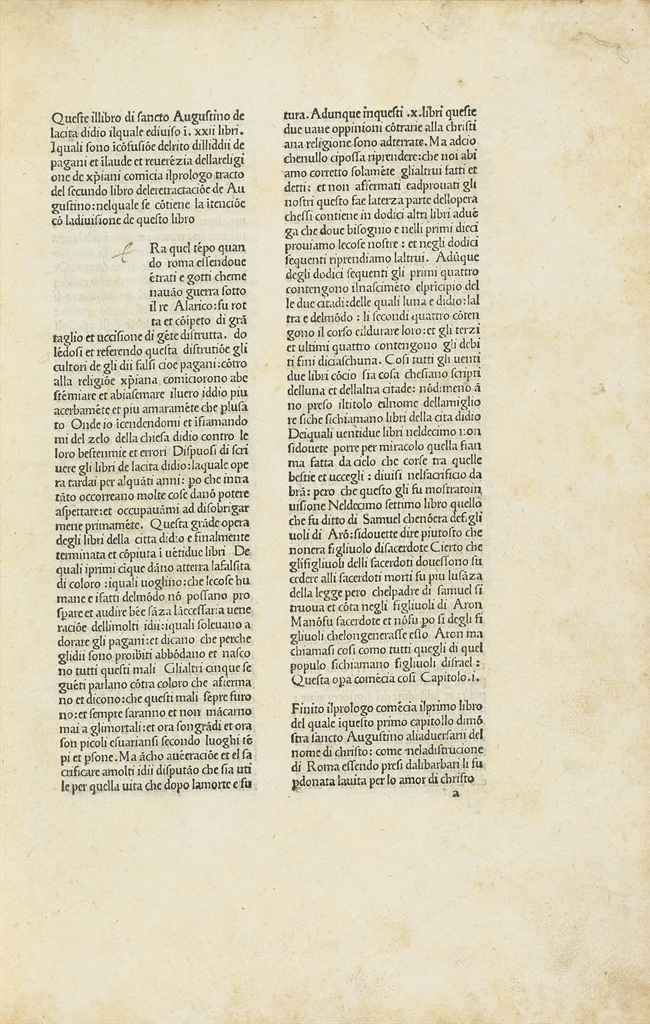AUGUSTINUS, Aurelius (Saint, 354-430). De civitate Dei . Rome: Conrad Sweynheym and Arnold Pannartz in the house of Petrus de Maximo, 1468. Royal 2 o (307 x 242 mm). Collation: [1-2 8 (1/1 blank, 1/2r rubrication table, 2/8 blank); 3-14 1 0 15 1 2 16-26 1 0 27-28 8 (3/1r text, 28/6v colophon, 28/7-8 blank)]. 268 leaves (of 274, without text leaves 1/2 and 3/1 and the 4 blank leaves). 46 lines. Type: 2:115R. 2-, 6-, 7-, 10-, and 15-line initial spaces, manuscript guide letters supplied. 21 (of 22) large illuminated white-vine initials by a contemporary Roman artist (eighteen 7-line, two 10-line, and one 6-line), 2 with marginal extensions (shaved); two-line roman initials and paragraph marks in rubrication table in alternating blue and red. Calligraphic book and chapter headings supplied in red. (First leaf stained and with a few small tears to fore-edge, occasional minor dampstaining in upper margins, some staining in gutters, a few other small stains at front and back, a few leaves a bit browned, worming to first quire and to last 2 leaves affecting a few letters.) Modern vellum over pasteboard, 18th-century morocco spine label preserved, mottled edges. Provenance : 16th-century marginal notes to first text leaf -- a few 18th-century marginalia. ONE OF THE FIRST BOOKS PRINTED IN ROME. Second edition, first Roman edition. The text is a reprint of the first edition of the previous year, the last of four books printed at Sweynheym and Pannartz's first press at Subiaco. Conrad Sweynheym of Mainz, probably one of the workmen for Fust and Schoeffer who fled after the sack of Mainz in October 1462, and his partner Arnold Pannartz of Cologne set up a printing press in 1463 or 1464 at the Benedictine monastery of St. Scholastica at Subiaco, a monastery inhabited almost entirely by German monks, and until recently honored as the birthplace of printing in Italy. In 1467, possibly at the behest of Cardinal Bessarion, Sweynheym and Pannartz set up a new printing press in Rome, in the house of the brothers Franciscus and Petrus de Maximis. By the end of the year they had printed there an edition of Cicero, Epistolae ad familiares , using a new roman fount, replacing the semi-gothic type used in Subiaco. In 1468 four editions followed, of which the Augustine is accepted as the third. A total of 51 editions, including a third edition of Augustine's magnum opus (1470), are now recorded from this first Roman press, which remained active until 1473. As the most substantial Latin source of classical philosophy available during the Middle Ages and Renaissance, Augustine's apologia of Christianity was treasured by humanist scholars. This accounts for the work's appearance at the head of Sweynheym and Pannartz's publishing program, commenced in Subiaco and pursued in Rome under the editorial direction of Giovanni Andrea Bussi, secretary to Cardinal Bessarion (previously to Nicolaus de Cusa) and future papal librarian. Along with the works of Lactantius and Cicero's Epistolae ad familiares , De civitate dei was one of only three texts published by Sweynheym and Pannartz to require a third edition. Bussi's complete list of the partners' output, printed in 1472 in the final volume of Nicolaus de Lyra's commentary on the Bible as part of an appeal to the Pope for financial assistance for the struggling press, gives a combined press-run for the three editions of 825 copies, each edition consisting of 275 copies. Although the opening text page with its finely illuminated border, along with the first leaf of the rubrication tables, have sadly been removed from the present copy, it is evident that both the rubrication and the illumination closely match those of the Estelle Doheny copy (cf. Doheny I, 78), and would thus appear to have been executed by the same scribe and artist, possibly working in the same atelier. HC 2047; GW 2875; BMC IV, 5 (IC. 17107); CIBN A-676; IGI 967; Pr 3293; Goff A-1231.
AUGUSTINUS, Aurelius (Saint, 354-430). De civitate Dei . Rome: Conrad Sweynheym and Arnold Pannartz in the house of Petrus de Maximo, 1468. Royal 2 o (307 x 242 mm). Collation: [1-2 8 (1/1 blank, 1/2r rubrication table, 2/8 blank); 3-14 1 0 15 1 2 16-26 1 0 27-28 8 (3/1r text, 28/6v colophon, 28/7-8 blank)]. 268 leaves (of 274, without text leaves 1/2 and 3/1 and the 4 blank leaves). 46 lines. Type: 2:115R. 2-, 6-, 7-, 10-, and 15-line initial spaces, manuscript guide letters supplied. 21 (of 22) large illuminated white-vine initials by a contemporary Roman artist (eighteen 7-line, two 10-line, and one 6-line), 2 with marginal extensions (shaved); two-line roman initials and paragraph marks in rubrication table in alternating blue and red. Calligraphic book and chapter headings supplied in red. (First leaf stained and with a few small tears to fore-edge, occasional minor dampstaining in upper margins, some staining in gutters, a few other small stains at front and back, a few leaves a bit browned, worming to first quire and to last 2 leaves affecting a few letters.) Modern vellum over pasteboard, 18th-century morocco spine label preserved, mottled edges. Provenance : 16th-century marginal notes to first text leaf -- a few 18th-century marginalia. ONE OF THE FIRST BOOKS PRINTED IN ROME. Second edition, first Roman edition. The text is a reprint of the first edition of the previous year, the last of four books printed at Sweynheym and Pannartz's first press at Subiaco. Conrad Sweynheym of Mainz, probably one of the workmen for Fust and Schoeffer who fled after the sack of Mainz in October 1462, and his partner Arnold Pannartz of Cologne set up a printing press in 1463 or 1464 at the Benedictine monastery of St. Scholastica at Subiaco, a monastery inhabited almost entirely by German monks, and until recently honored as the birthplace of printing in Italy. In 1467, possibly at the behest of Cardinal Bessarion, Sweynheym and Pannartz set up a new printing press in Rome, in the house of the brothers Franciscus and Petrus de Maximis. By the end of the year they had printed there an edition of Cicero, Epistolae ad familiares , using a new roman fount, replacing the semi-gothic type used in Subiaco. In 1468 four editions followed, of which the Augustine is accepted as the third. A total of 51 editions, including a third edition of Augustine's magnum opus (1470), are now recorded from this first Roman press, which remained active until 1473. As the most substantial Latin source of classical philosophy available during the Middle Ages and Renaissance, Augustine's apologia of Christianity was treasured by humanist scholars. This accounts for the work's appearance at the head of Sweynheym and Pannartz's publishing program, commenced in Subiaco and pursued in Rome under the editorial direction of Giovanni Andrea Bussi, secretary to Cardinal Bessarion (previously to Nicolaus de Cusa) and future papal librarian. Along with the works of Lactantius and Cicero's Epistolae ad familiares , De civitate dei was one of only three texts published by Sweynheym and Pannartz to require a third edition. Bussi's complete list of the partners' output, printed in 1472 in the final volume of Nicolaus de Lyra's commentary on the Bible as part of an appeal to the Pope for financial assistance for the struggling press, gives a combined press-run for the three editions of 825 copies, each edition consisting of 275 copies. Although the opening text page with its finely illuminated border, along with the first leaf of the rubrication tables, have sadly been removed from the present copy, it is evident that both the rubrication and the illumination closely match those of the Estelle Doheny copy (cf. Doheny I, 78), and would thus appear to have been executed by the same scribe and artist, possibly working in the same atelier. HC 2047; GW 2875; BMC IV, 5 (IC. 17107); CIBN A-676; IGI 967; Pr 3293; Goff A-1231.



.jpg)
.jpg)








Testen Sie LotSearch und seine Premium-Features 7 Tage - ohne Kosten!
Lassen Sie sich automatisch über neue Objekte in kommenden Auktionen benachrichtigen.
Suchauftrag anlegen